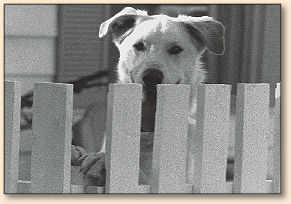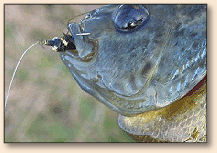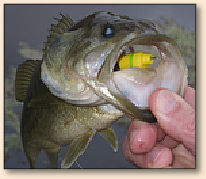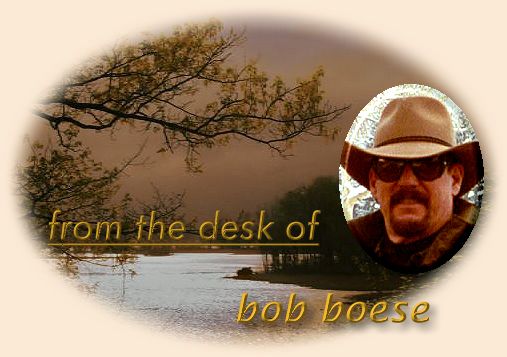|
Louisiana is currently in the midst of its every afternoon
thundershowers routine and, between lightning strikes, my
quite large dogs are shivering, while attempting to possess
the exact space I happen to be occupying. Meanwhile, the
cat, Yogi, is sitting under the carport on the truck hood daring
anything to flee from the wet within his range of view. Fly
fishermen can learn a lot from dogs and cats. The lessons
they teach aren't the same, but they are related, in a perverse
sort of way.
 Dogs eat practically anything – dog food, leftovers, garbage,
road kill and the oyster poorboy you put on the back of the
stovetop thinking it was safe. Anything. Don't believe for a
minute dogs and chocolate are antithetical. My sled dog will
gnaw on a cereal box, but that's about it, yet he will hunt through
the cupboard for Oreos and leave nothing but mangled cellophane.
Halloween's leftover York peppermint patties went down and out
foil and all. He gnawed open a new jar of peanut butter and lapped
out half. Yep, dogs are voraciously omnivorous. They consume
whatever is available with gusto and enthusiasm, grateful for any
opportunity to snack. Dog psyche says "eat it fast or someone else
will" … even if there is no someone competing for the food.
There is serious doubt that dogs taste half of what they take in,
unless it is that heartworm pill you have to hide in a pat of butter
to get swallowed.
Dogs eat practically anything – dog food, leftovers, garbage,
road kill and the oyster poorboy you put on the back of the
stovetop thinking it was safe. Anything. Don't believe for a
minute dogs and chocolate are antithetical. My sled dog will
gnaw on a cereal box, but that's about it, yet he will hunt through
the cupboard for Oreos and leave nothing but mangled cellophane.
Halloween's leftover York peppermint patties went down and out
foil and all. He gnawed open a new jar of peanut butter and lapped
out half. Yep, dogs are voraciously omnivorous. They consume
whatever is available with gusto and enthusiasm, grateful for any
opportunity to snack. Dog psyche says "eat it fast or someone else
will" … even if there is no someone competing for the food.
There is serious doubt that dogs taste half of what they take in,
unless it is that heartworm pill you have to hide in a pat of butter
to get swallowed.
Cats are basically carnivorous and eat only what they want
only when they want, even if the offering is the finest of canned
feline gourmet fare. And even a hungry cat will ignore the most
expensive cat food if it thinks someone is trying to get it to eat.
[Interestingly enough, a cat can't survive solely on dry dog food
because dog food lacks the necessary percentage of meat protein
for the feline constitution.] Cats like killing things and frequently
like eating their kill, but mostly they like killing things. Of course,
leave a grilled chicken breast alone for a while with my house cat
and you'll know he is related to tigers … as the spirits of birds and
lizards and mice and squirrels will confirm. Dogs are simply vacuums
for what's easily available, unless the cat killed it, in which case
they are suspicious the cat left it as bait.
Largemouth bass and big bluegill don't usually eat each other, so
they don't mess much with each other. Bluegill are laterally compressed
(plate shaped), and, contrary to general belief, large bluegill are harder
for bass to swallow than much bigger torpedo shaped fish (like other
bass or shad) and are harder to get down than most bass are willing
to deal with, thus are not usually on the entree list. Tolerance doesn't
mean they like each other – au contraire – and
they frequently compete for the same food. But, bass are the dogs of
the pond. Other than vegetation, if it's alive and in or on the water, it's
on their menu. Bass fry change their diet from zooplankton to fish as
soon as possible and turn into deadly hunters in only a few weeks.
Bass can digest most anything in their environment and have the ability
to swallow prey nearly their own size. Tasting is not part of the pre-feast
protocol and if it might be edible it's worth a try. Hence the success of
the resembles-nothing buzz bait. Bass eating insects is like your dog taking
in pizza crumbs – not very filling but tasty. Fingerling bass eat a lot
of insects and remember how swell a nymph tasted as they grow. Given
the choice between a shad, a crawfish and an ant, the ant comes in a poor
third. But ….if the ant happens to be hanging around as a bass hunts
for shad or crawfish, it's snackage. For this reason, a fly doesn't have to
look too much like an insect to get eaten, just sort of food-ish.

In comparison, while their diet is varied, a large bluegill's mouth is
only wide enough to accommodate relatively small items and their
preference is easy-to-catch delicacies, like insects. Bluegill spend
most of their young lives not wanting to get eaten, so they develop
an educated palate for the various types of vegetation they hide
among. Because they are familiar with water plants, they learn to
be selective in both their vegetarian diet and live entrees. In cat-ish
fashion, they sort of play with their food, tasting before eating,
sometimes tasting several times first. Big bluegill generally ignore
dead fare and, given a choice of main course, will select dinner by
either mood or memory. If the bluegill feels like eating and your fly
looks like food and something resembling your fly tasted like food
before, bluegill think it's probably food.
 Yogi is an indoor-outdoor cat who rules his domain with fang and claw.
Even when sleeping he is hunting and his very sharp claws will extend
and retract with dreams of prey. He will occasionally venture to the
neighbor's yard, but only to show off for the neighbor's calico. Dogs
like exploring…because it might take them near food. Let Ozzie,
my daughter's sled dog, loose and you will find him miles away, head
cocked to the side, wondering why it too you so long to catch up. Cats
like marking territory and staying nearby. Dogs are smell oriented and,
while running past things, they barely notice whether they are black or
white or grey-ish and darker grey-ish. Cats practically count the leaves
on every bush in their territory and, unless it saves a cat the trouble by
moving, a feline can distinguish a chamaeleon based on leaf count. Dogs
will chase prey for long distances. Cats, unlike their larger cousins in the
wild, like waiting for prey to enter the danger zone then attack in short
quick movements. In the lake, bass don't explore so much as they prowl
a water body, hunting for any might-be-food that moves, like fish and
ducks and frogs. Their sense of smell is sharp but primarily they hunt
with their lateral line nerve system, which can detect the slightest vibrations.
Since they are usually the top of the food chain, anything they detect moving
is a potential meal. Just because they haven't eaten a chartreuse popping bug
before doesn't mean they aren't going to test it's edibility. Meanwhile, bluegill
stalk quietly around vegetative cover and prefer food that won't move fast,
such as insects floating in the water. In most instances, a fly has to come
much closer to a bluegill to entice it than it would for a bass.
Yogi is an indoor-outdoor cat who rules his domain with fang and claw.
Even when sleeping he is hunting and his very sharp claws will extend
and retract with dreams of prey. He will occasionally venture to the
neighbor's yard, but only to show off for the neighbor's calico. Dogs
like exploring…because it might take them near food. Let Ozzie,
my daughter's sled dog, loose and you will find him miles away, head
cocked to the side, wondering why it too you so long to catch up. Cats
like marking territory and staying nearby. Dogs are smell oriented and,
while running past things, they barely notice whether they are black or
white or grey-ish and darker grey-ish. Cats practically count the leaves
on every bush in their territory and, unless it saves a cat the trouble by
moving, a feline can distinguish a chamaeleon based on leaf count. Dogs
will chase prey for long distances. Cats, unlike their larger cousins in the
wild, like waiting for prey to enter the danger zone then attack in short
quick movements. In the lake, bass don't explore so much as they prowl
a water body, hunting for any might-be-food that moves, like fish and
ducks and frogs. Their sense of smell is sharp but primarily they hunt
with their lateral line nerve system, which can detect the slightest vibrations.
Since they are usually the top of the food chain, anything they detect moving
is a potential meal. Just because they haven't eaten a chartreuse popping bug
before doesn't mean they aren't going to test it's edibility. Meanwhile, bluegill
stalk quietly around vegetative cover and prefer food that won't move fast,
such as insects floating in the water. In most instances, a fly has to come
much closer to a bluegill to entice it than it would for a bass.
Yogi visits the lake shore occasionally, presumably to kill something,
but I think he is discussing strategy with the bass. Both the cat and the
bass are night hunters. Cat night vision is excellent and, after dark, bass
use a combination of vision and lateral line to find prey. In June a full
sized mocking bird was careless and, as darkness fell, it soon became
a clump of red streaked feathers that was deposited by the backdoor
next to a too slow field mouse. About that same time we had been
concerned with lake damage from new nutria offspring. It was an
unwarranted concern as the bass had only to decide whether to choose
from Column A with duckling puffs, Column B with bullfrog sushimi, or
Column C with the nutria tartar.
There is a tenuous peace in our house I have yet to fully understand.
She-Ra, my smaller dog (50 pounds small), used to come unglued at
the thought of a cat, and then Yogi and Ozzie moved in. Things were
very tense until a while back when a bad ginger cat backed my good
ginger into a corner and was actually winning, which tells you something
about the badness of that other cat. The dogs heard the cat fight and
Ozzie bolted from his leash to get a mouthful of bad cat. She-Ra was
standing with her hackles straight up, just waiting to play tag team and
eventually got her own taste of the evil feline – who has never
been seen since in our vicinity. Duh. Now Yogi sleeps in the dogs' beds
and the dogs share the cat's food, and they all climb in bed, together,
with my daughter. Strange bedfellows for sure. Bass and bluegill –
naw, it'll never happen.
Bubba's son, T'Bub, on tour with his Army Reserve division in
Afghanistan, had just gotten a furlough from several weeks of intense
action on the front lines. Finally granted R&R he was exhausted and
boarded a train bound for Cairo with a platoon of British troops. The
train was very crowded and T'Bub walked the length of the train,
looking for an empty seat. The only unoccupied seat was directly
adjacent to an expensively dressed French woman and was being
used by her poodle. The nasty tempered little dog growled and
snapped at T'Bub as he asked, "Please, ma'am, may I sit in that seat?"
The French woman looked down her nose at T'Bub, his chest filled
with campaign and award ribbons. She huffed and said, "You
Americans. You are such a rude class of people. Can't you see
my Little Fife is using that seat? Look you have upset her."
T'Bub walked away, looking to find any place to rest, but after
another trip down to the end of the train, found himself once more
facing the woman with the dog. The dog snarled as again he asked,
"Please, lady. May I sit there? I'm really very tired."
The woman wrinkled her nose and snorted, "Sacre Bleu! Americans!
Not only are you rude, you are also arrogant. Connard!"
Now, T'Bub didn't speak much French, but the Cajun boys in his
platoon had taught him some of the more notable insults, and this
was near the top of the list. Without saying anything else; he leaned
over, picked up the unpleasant little dog, tossed it out the window
of the train and sat down in the empty seat. The woman shrieked,
hit him with her purse, then stormed off looking for someone to
deal with T'Bub.
An English officer sitting across the aisle spoke up, "You know, sir,
you Americans do seem to have a penchant for doing the wrong thing.
You butcher the language. You eat holding the fork in the wrong hand.
You drive your autos on the wrong side of the road. And now, sir,
you've thrown the wrong bitch out the window." ~ Bob
About Bob:
Robert Lamar Boese is has fly fished for five decades. He is an
environmental negotiator, attorney and educator who has provided
environmental legal services for more than thirty-three years including
active duty with the U.S. Coast Guard and Department of Justice. He is a
well known fly tyer with several unique patterns to his credit. He has
developed and authored federal and state regulatory programs
encompassing a broad spectrum of environmental disciplines, has
litigated environmental matters at all levels of the federal and state
court systems, and is a qualified expert for testimony in environmental
law. He has authored over 60 published text chapters, comments or
articles on environmental matters, is a member of the Colorado, District
of Columbia and Louisiana Bar Associations, and is a certified mediator.
In addition to his legal practice, Mr. Boese has been a high school
teacher, an associate professor of Environmental Law and Public Health,
has authored numerous fiction and sports publications, and is a softball
coach and nationally certified volleyball referee. He is the president
of the Acadiana Fly Rodders in Lafayette, Louisiana and editor of
Acadiana on the Fly. He has been married for thirty years and is the
father of two fly fishing girls (25 and 21). For additional information
contact: Boese Environmental Law, 103 Riviera Court, Broussard, LA 70518
or call 337.856.7890 or email coachbob@ymail.com.
|



